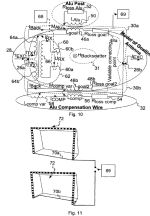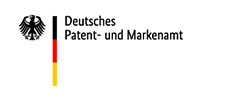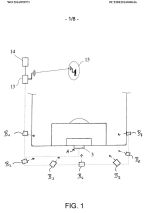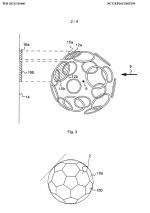Goal line technology and video assistant referee
3. Electronic positioning systems for players and ball

![]() Figure 4: Real-time determination system for monitoring the positions of ball and players, which are equipped with sensors (FR 2 695 042)
Figure 4: Real-time determination system for monitoring the positions of ball and players, which are equipped with sensors (FR 2 695 042)
Since the 2014 World Cup in Brazil, goal line technology has been used. The Video Assistant Referee (VAR) will be used for the first time at the 2018 World Cup in Russia. These two innovations not only represent the greatest changes in world football in decades, but are also extremely interesting from a technical point of view. Behind them are a huge amount of research, development and numerous ideas protected by IP rights.
This was preceded by a lengthy process: even the "Funkfahne (radio flag)", which enables electronic communication between line and referee, only found its way into professional football about thirty years after its application to the DPMA. The admission of the goal line technique came only just about a little bit faster.
The "Wembley Goal" of 1966, which was not one, stirred people's minds (especially in Germany) for decades. When vice versa the English side did score a clear goal against Germany at the 2010 World Cup which was not acknowledged by the referee, even FIFA recognised that it was time to finally use the existing technical possibilities to help a game to run fairly and in compliance with the rules. After long testing phases, it has accepted several systems with which it can be determined beyond any doubt whether the ball has crossed the goal line in its entirety or not.
It really isn't easy for the referee: A ball must have been behind the goal line for at least 60 milliseconds for his human eye to even recognize it. However, since the shooting speed is nowadays sometimes up to 120 km/h, this is often not the case with a rebound from the bar - as was the case in 2010 with Frank Lampard's goal against Manuel Neuer, which was not recognized by the referee. This is where technology can help today.
In accordance with FIFA rules, the goal line technique reports to the referee (and only to him!) whether the ball has crossed the goal line in full. The goal is displayed on the special watch of the impartial. The information is transmitted within one second so that the referee can react immediately and the game is not interrupted or otherwise impaired.
FIFA has approved two types of goal-line technique:
Camera-based:
Several approved technologies work with cameras that locate the ball, as well as with software that evaluates the images of all cameras. The system can thus determine whether the ball has crossed the goal line in its entirety.
An example of this technique is "System and method of preparing a playing surface" (US7846046B2). Under the name "Hawk Eye" this method has been used in tennis for years.
The "GoalControl" system from the German company of the same name works with several cameras per goal, which are anchored partly directly at the goal and partly as high up in the stadium structure as possible. All are connected to a computer unit. The "Goal recognition system and method for recognizing a goal" (WO 2014059971 A1) has proven itself useful since the World Cup in Brazil.
Magnectic field based:
Other systems work with magnetic fields. Cables are installed in the floor and around the gates. The ball is also equipped with receivers (see also "Intelligent Ball" and "Game Analysis"). Through the interaction between the receivers in the ball and the magnetic fields generated by the cables in the ground, the software can calculate the exact position of the ball and determine whether a goal has been scored.
Examples of this are the radio-based systems of Goalref and Cairos.
GoalRef of the Danish company of the same name is based on a development by the Fraunhofer Institute for Integrated Circuits IIS. Its operation method: There is a magnetic field in the goal (WO 2009/046722 A1), in football there are coils (WO 2013/149681 Al). When the ball enters the goal magnetic field, it builds up its own field by induction. The magnetic field of the ball is detected by the magnetic field change inside the goal by the antennas mounted there. The evaluation unit reads and evaluates the data. If the ball is fully behind the line, a clear signal is generated. The result is now encrypted and transmitted to the referee in real time. Goalref patented the system under the title "Tordetektor für die Erfassung eines durch eine Torebene gehenden Gegenstands (Goal detector for detecting an object passing through a goal plane") (DE6706107T1, see also EP1596945B1).
Like GoalRef, the Cairos company from Karlsbad in Germany uses a magnetic field technology. Its " Vorrichtung und Verfahren zum Erzeugen eines Magnetfeldes in einem Torraum zur Torentscheidung (Apparatus and method for generating a magnetic field in a gate chamber for gate decision)" (DE102007009232B3) includes a coil behind and a coil inside the goal, respectively. It also uses a magnetic field sensor in the ball (DE 10 2008 052 215 B4), which sends a signal to the referee when he has crossed the goal line.
Other approaches

![]() Method for determining the transit of a moving object through a detection plane (US 2016/0107028 A1)
Method for determining the transit of a moving object through a detection plane (US 2016/0107028 A1)
In addition, there have always been new ideas on this issue:
The Fraunhofer-Gesellschaft continued its research on this topic and in 2016 received a US patent for an antenna system and a method for determining the transit of a moving object through a detection plane (US 2016/0107028 A1, see figure).
The "Ballerkennungsvorrichtung (ball detection device)" DE 102008059095 A1 provides a kind of light barrier for gate detection.
The "Vorrichtung zur Erfassung, Auswertung und Anzeige von Daten (Device for recording, evaluating and displaying data)" (DE102007050062A1) is based on the principle of a beam grating with reflective elements that is intended to reliably detect a goal.
The invention "Überwachungsvorrichtung für ein Spielfeld (Monitoring device for a playground)" (DE102006020018A1) is very complex, but probably also suitable for monitoring offside positions. It provides movable measuring radiators at the edge of the playground.
DE102005048276B3 describes a "method of tracking a game element, e.g. a ball or a puck on a playground" using coupled cameras that monitor certain sectors.
A "tracking system" describes EP 1 666 916 A2: It provides for the radio location of the ball to support the referee, e.g. in goal decisions. Players can also be located.
There are also approaches to ultrasonic football location (US 2007/0216576 A1, "Ultrasonic Football Linesman").
EP 2 375 267 A1 describes a tracking system in which not only the ball but also the players are networked with GNSS (GPS) receivers for precise positioning.
| Publication number | Year | Title | Brief description |
|---|---|---|---|
| WO 2007/099502 A2 | 2006 | Method and System for the Automatic Detection of Events in Sports Fields | Camera-based system with quick image processing and real time calculation of trajectories of moving objects for determining the position of the ball near the goal |
| WO 2006/111928 A2 | 2006 | Method and system for the detection and the classification of events during motion actions | Another localisation system for detecting offside positions, in particular |
| DE 10 2005 013 225 A1 | 2005 | Objektverfolgungs- und Situationsanalysesystem | Object tracking and situation analysis system with central positional data processing unit that selectively activates and controls the individual detecting units for tracking specific objects (ball or individual players) |
| WO 03/070336 A1 | 2003 | Sistema de dispositivos electronicos de ayuda abritral para el futbol | System for capturing the positions of players and ball; generates electronic and optical signals to indicate offside positions or goals |
| DE 102 52 934 A1 | 2002 | Verfahren zur kontinuierlichen Echtzeitverfolgung der Position von wenigstens einem mobilen Objekt sowie zugehörigen Sendern und Empfängern | Positioning system for electronic real-time monitoring of actions on a football pitch |
| WO 01/02067 A1 | 2000 | Sistema de deteccion del fuera de juego | Localisation system signalling a possible offside position to the assistant referee, who decides whether or not the signal shall be transmitted to the referee |
| FR 2 726 370 B1 | 1994 | Systeme de controle du positionnement dans le domaine du sport, d'une balle et des joueurs | System for determining the position of players and ball and for detecting offside positions |
| CH 628 192 A | 1978 | Fernsehanlage für die Überwachung und Beurteilung bzw. Leitung von Feldspielen, insbesondere Fussballspielen | Video system for superimposing match images, with coordinates for direct checking of decisions by the referee |
Video Assistant Referee (VAR)
At the 2018 Football World Cup in Russia, the Video Assistant Referee will be used for the first time in a major tournament.
The VAR team consists of professional referees and is stationed in Moscow during the World Cup. There it has access to 33 transmission cameras for all games, eight of which are super slow motion and four ultra slow motion cameras. According to FIFA, the team also exclusively has two offside cameras at his disposal.

![]() Flying drone with monitor which allows the referee to watch a video replay without having to leave the pitch (WO002017/221078A2)
Flying drone with monitor which allows the referee to watch a video replay without having to leave the pitch (WO002017/221078A2)
Four replay operators select the best camera angles and make them available to the VAR team. During a game, the VAR team constantly pays attention to clear and obvious wrong decisions in game-decisive situations. Only then, or in the event of serious incidents that have been overlooked, will the VAR communicate with the referee on the pitch.
In the future, developments such as "Device, method and program for image processing" (EP3300022A1) will further advance this technology. It describes an image processing method with which the area of a foreground object can be extracted with high accuracy. It works with a complex combination of units for target and reference image acquisition, conversion and extraction.
At present, the referee still has to leave the pitch if he wants to use the Video Assistant Referee, as the monitors are set up on the side of the playground. WO002017/221078A2 would like to change this and suggests that the video image be brought to the referee in the future. Either in the form of a mobile robot or a flying drone, each with an installed screen on which the controversial game scene can be played.
Cameras in stadium
There are always new ideas for installing cameras in the stadium and controlling them. Here are a few examples:
DE 202016005415 U1 describes a camera mounting system for sports field floodlight poles for mobile video recording of football matches from an elevated position (similar to DE 202017004719 U1).
The "Video-Überwachungssystem (video surveillance system)" DE 102006012239 A1 is used for camera control, e.g. for football broadcasts.
Similarly, the "Tracking system using proximity and/or presence" (US 020110205077 A1) supports camera control.

![]() Utility model "Positionserfassungssystem oder Kamerasystem für eine Spielstätte" (DE 202017005123 U1)
Utility model "Positionserfassungssystem oder Kamerasystem für eine Spielstätte" (DE 202017005123 U1)
DE 202017005123 U1 provides that the display on the board display is adapted to the game situation. The game situation is recorded by cameras which can be used to determine the position of the players. From the calculated positions the game situation is recognized, which influences the setting of the cameras and the representation on the banner display.
Perhaps this has great potential for situationally suitable perimeter advertising: painkillers or patches for fouls, spectacle advertising for referee mistakes, maritime equipment for a ?dive?, strong liquor advertising (for the nerves) for penalties...
Referee control
The referee himself can also be closely monitored today. A patent application has recently been filed for a development that aims to analyse and interpret the referee's actions using "gaze data" (US020170364753A1). Development involves identifying Key Performance Indicators (KPI) and collecting data during the match to assess whether the referee's decisions are correct. The system should even be able to assess the likelihood that the referee may be biased or wether this may influence his decisions. The KPI data can be collected over several matches to create a reliability profile for the referee.
Developments such as US020180039825A1 can also be helpful in assessing referee performance, which is a playback segment extraction procedure that automatically detects any referee intervention in a video and extracts the corresponding match segment from the film, which should facilitate the subsequent assessment of referee performance.


